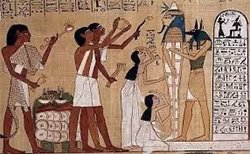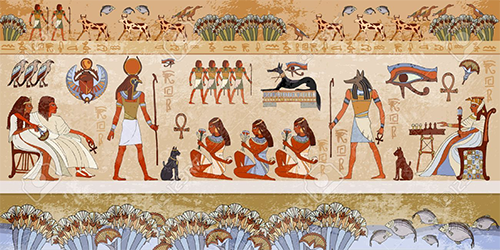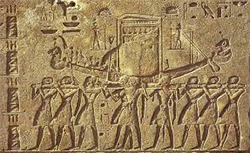Religion in Ancient Egypt
Part 2: Temples, Priests, and Festivals Most cities had patron gods. The people of Thebes, for example, early on worshiped Monthu as their patron god; in time, that worship shifted to Amen, who many people saw as the chief god over all. The idea that Amen, the creator god, and Re, the sun god, were linked led to the worship of Amen-Re. In drawings and carvings, the Egyptians used animals such as birds, cats, cows, crocodiles, lions, and rams to represent gods and goddesses. The creator god Kephre, for example, was depicted as a scarab beetle, either entirely or with a human body. Sobek was a crocodile god often shown as a man with a crocodile's head; a temple to Sobek still exists at Kom Ombo. One well-known animalistic depiction of a deity was the representation of the funerary god Anubis as a jackal. Differing depictions of deities implied mood: An angry god might be shown as a lion, and a god in a nonthreatening mood might be shown as a gentle cat. As well, kings were often depicted with part of their body in animal form.  The Egyptians associated their kings with certain gods, such as Horus; indeed, many works of art from ancient times show pharaohs with characteristics of a falcon, the animal with which Horus is most associated. The Egyptian people associated their kings also with Amen, who for much of Egyptian civilization was the chief god, and with the sun god, Ra, who served as a father figure for the pharaoh. The people viewed their pharaoh, the king, as the intermediary between themselves and the gods. The pharaoh, whom the people was descended from the gods, was in charge of the various rituals and offerings and houses of worship for the goods deemed most important. It was the pharaoh's task to sustain the balance between order and chaos on Earth by maintaining the gods' blessings for him and his people. When the civilization prospered, people believed that the pharaoh was doing what needed to be done and that the gods were happy; when times were tough, people tended to think that they or their king had somehow angered the gods. Temples and Priests 
It was up to the priests to keep sacred and safe the various papyri and books containing texts regarding such rituals and beliefs. Also commonly found in these written collections were prayers and hymns to different deities. Priests fulfilled this mission by storing these sacred texts in temple libraries. Writing those sacred texts were temple scribes. Pharaohs made it a habit to enhance existing temples and build new ones, often using materials from other structures, including temples. One extreme example of this was the Precinct of Amun-Ra at Karnak, viewed by many historians as the world's second-largest center of worship. At this and most other temples, the Egyptians filled the walls with hieroglyphs and depictions of events in the lives of the kings and of the general populace. Religious Festivals One of the largest regular festival was the Beautiful Festival of the Wadi, which honored the god Amun and was a festival celebrating community in the form of honoring the souls of the dead. Other well-known festivals were these:
Next page > Death and the Afterlife > Page 1, 2, 3
|
|
Social Studies for Kids
copyright 2002–2026
David White



 The people built many temples and dedicated them to various gods. Maintaining these temples and the rituals housed therein were a large number of priests, whose influence and power waxed and waned with the sands of time. First and foremost, the high priest was often a stand-in for the pharaoh in times of worship. High priests and other leaders performed their duties full-time, for their entire lives, and got their positions either from an appointment by the pharaoh or because their father was an important priest. Lower level priests were appointed from the population at large and served for a limited amount of time before returning to their former situation. Priests were both men and women, although a priest was usually the same gender as the deity in whose temple he or she served. One of the primary duties of the priests was to maintain the sanctity and viability of the statue of the deity to whom the temple was dedicated. The Egyptians believed that the statue was imbued with the spirit if not the presence of the god, and so they took great care of the statue and its surroundings. Only the high priest could attend to the statue; other priests busied themselves with keeping the temple clean and welcoming. The high priest mainly but also other priests performed various rituals and blessings for the god of the temple and conducted ceremonies for the rest of the population.
The people built many temples and dedicated them to various gods. Maintaining these temples and the rituals housed therein were a large number of priests, whose influence and power waxed and waned with the sands of time. First and foremost, the high priest was often a stand-in for the pharaoh in times of worship. High priests and other leaders performed their duties full-time, for their entire lives, and got their positions either from an appointment by the pharaoh or because their father was an important priest. Lower level priests were appointed from the population at large and served for a limited amount of time before returning to their former situation. Priests were both men and women, although a priest was usually the same gender as the deity in whose temple he or she served. One of the primary duties of the priests was to maintain the sanctity and viability of the statue of the deity to whom the temple was dedicated. The Egyptians believed that the statue was imbued with the spirit if not the presence of the god, and so they took great care of the statue and its surroundings. Only the high priest could attend to the statue; other priests busied themselves with keeping the temple clean and welcoming. The high priest mainly but also other priests performed various rituals and blessings for the god of the temple and conducted ceremonies for the rest of the population. Opet: a 20-day festival featuring veneration of Amen by transporting a statue of him through the streets of Thebes and then back into the temple
Opet: a 20-day festival featuring veneration of Amen by transporting a statue of him through the streets of Thebes and then back into the temple

